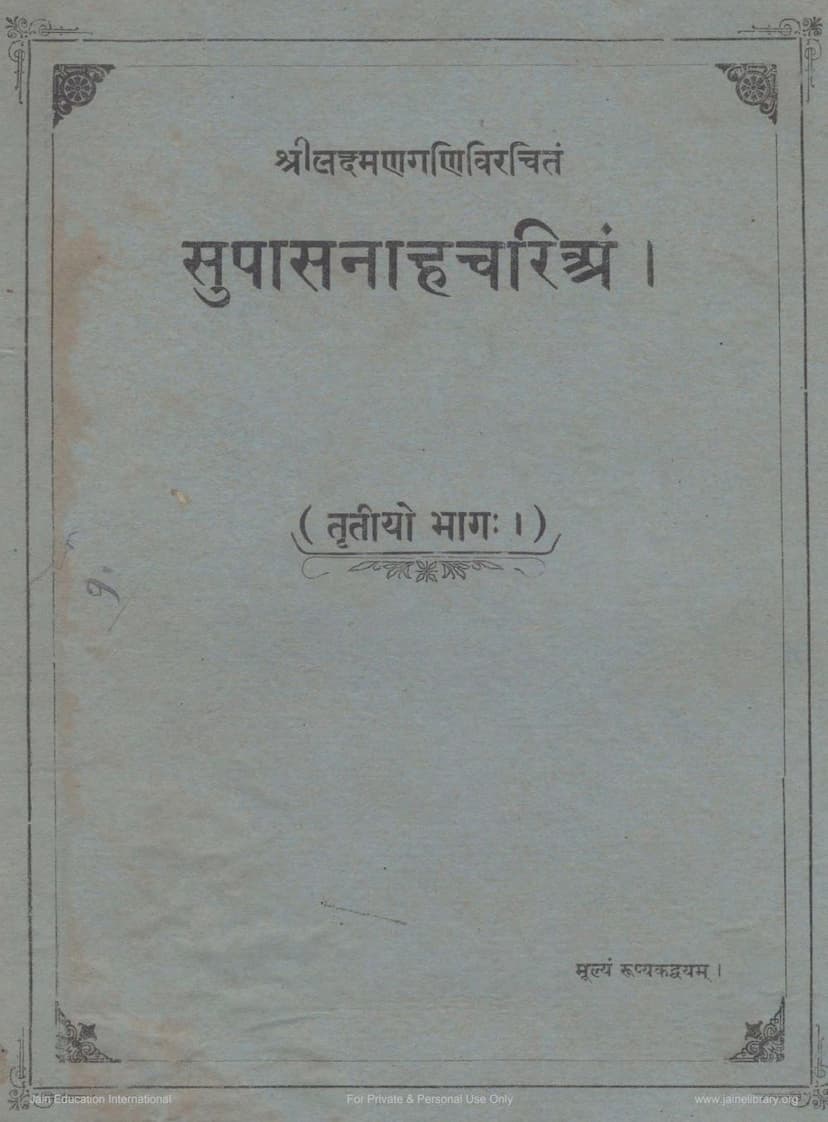Supasnahachariyam Part 03
Added to library: September 2, 2025

Summary
This document, Supasnahachariyam Part 03, authored by Lakshmanagani and edited by Pandit Hargovind Das T. Sheth, is the third volume of a larger work titled "Supasnahachariyam." Published in Benares in 1919 by the Jaina Vividha Sahitya Shastra Mala Office, this part is priced at two rupees.
The book is a part of a series called "Jaina Vividha Sahitya Shastra Mala," specifically volume number 12. It presents the life and deeds of Bhagavan Suparshvanath, the seventh Tirthankara. The text is described as extensive and poetic, written in Prakrit.
The editor, Pandit Hargovind Das T. Sheth, highlights several key aspects of the work:
- Content: The book primarily deals with the teachings of Bhagavan Suparshvanath and elaborates on the twelve vows of lay followers (shravakas), including their five transgressions (aticharas). It uses individual stories to illustrate the rewards of vow observance and the consequences of transgressions. Beyond religious instruction, the author also includes descriptions of contemporary social customs, political situations, religious sentiments, and ethical life, making it a valuable resource for understanding the era.
- Language and Structure: The text is in Prakrit, which the editor acknowledges can be difficult for even Sanskrit scholars to understand without proper study of Prakrit grammar and literature. The work is divided into sections called "parichchheda" or "vishvasaka." The editor notes that the original text's structure wasn't clearly demarcated by chapter divisions, so they have established a sectioning based on the concluding sentences of each narrative, which are provided in Sanskrit. The Sanskrit verses interspersed within the text have been removed and printed separately for clarity.
- Sanskrit Translation (Chhaya): Recognizing the difficulty of Prakrit, the editor has provided a Sanskrit translation, referred to as 'Chhaya,' which is placed below the original Prakrit text. This translation aims to be faithful to the original grammatical structure and meaning, adhering to the practice of earlier commentators. The editor explains the methodology behind this translation, including how multiple Sanskrit equivalents for a single Prakrit word are handled, how puns (shlesha) are addressed, and the decision-making process when the origin of a Prakrit word (whether Sanskrit, Tadbhava, or Deshya) is debated among scholars. They generally favor the Sanskrit form when it fits the context or follows prevalent grammatical rules.
- Historical Context: The author, Lakshmana Gani, is identified as a scholar who was active in the 12th century, with a significant presence in Gujarat. The work's beginning in Dandhukkuyanagara and its completion in Mahemlipuri in the year 1199 of the Vikram era (during Kumarapala's reign) are mentioned to establish its historical timeline.
- Author's Guru Lineage: A detailed guru lineage is provided: Jayasingha Suri -> Abhayadev Suri -> Hemachandra Suri -> Vijayasingha Suri -> Shri Chandra Suri -> Vibudhachandra Suri -> Lakshmana Gani. The editor notes the historical importance of Abhayadev Suri and Hemachandra Suri's accounts as presented by Shri Chandra Suri in his work on Munisuvrataswami.
- Editorial Process: The editor expresses deep gratitude to the late Muni Rajraj Vijay for his guidance and to the donors who financially supported the publication. They acknowledge the difficulty of translating and annotating such ancient texts due to the scarcity of complete manuscripts and commentaries. The editor outlines their approach to deciphering and translating obscure words, relying on contextual clues, cross-referencing with other texts, and applying linguistic principles.
- Manuscript Sources: The editor lists three primary manuscripts used for this edition: one from the collection of Pandit Kantivijaya, another from Muni Rajvijay, and a third also from Pandit Kantivijaya. They acknowledge that all these manuscripts are not entirely free of errors and express hope that the readers will be forgiving of any remaining inaccuracies.
The introduction also includes a detailed appendix listing the various stories and topics covered in the text, categorized by the Jain vows and their transgressions. This table of contents spans from page 197 to 658, covering numerous narratives, each illustrating a specific ethical or religious principle within Jainism.
In essence, Volume 3 of Supasnahachariyam is a scholarly edition of a significant Jain religious and literary work, offering a Prakrit narrative enriched with a Sanskrit translation, historical context, and detailed guidance on its interpretation.